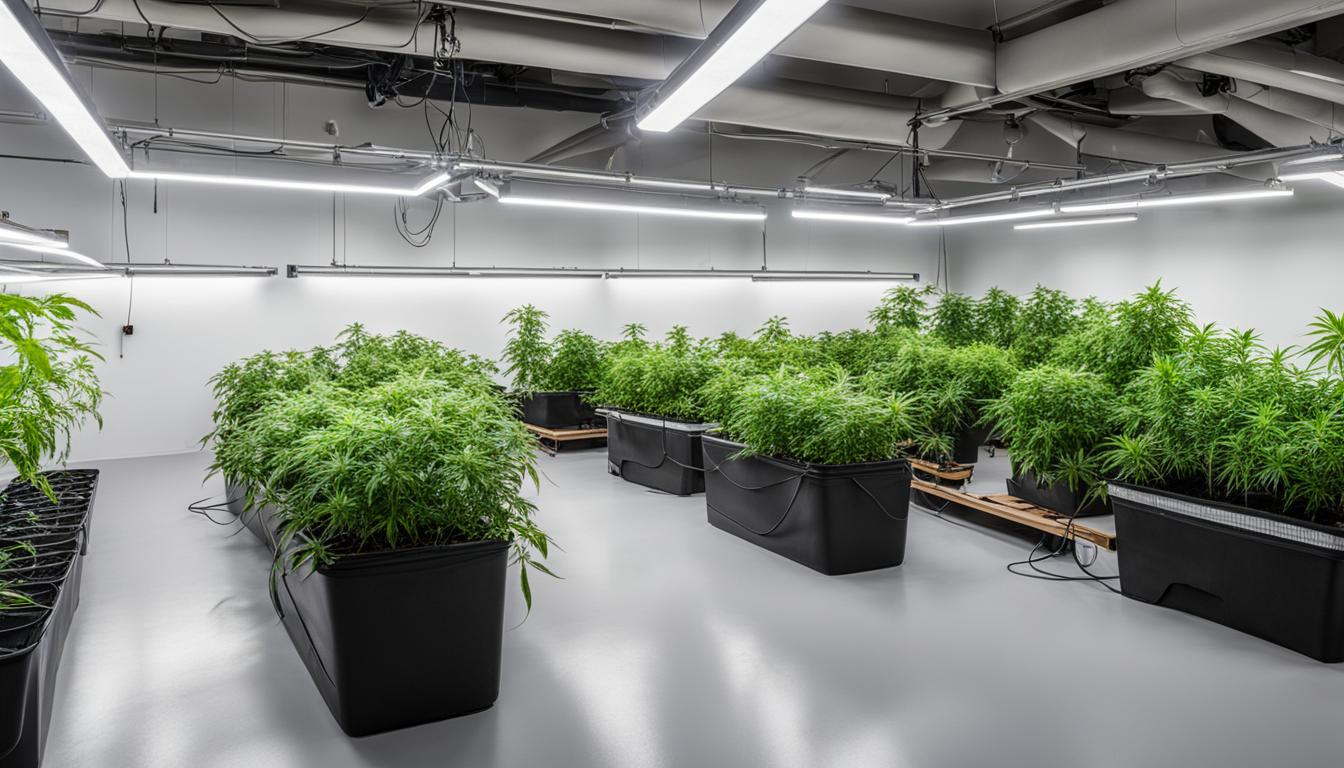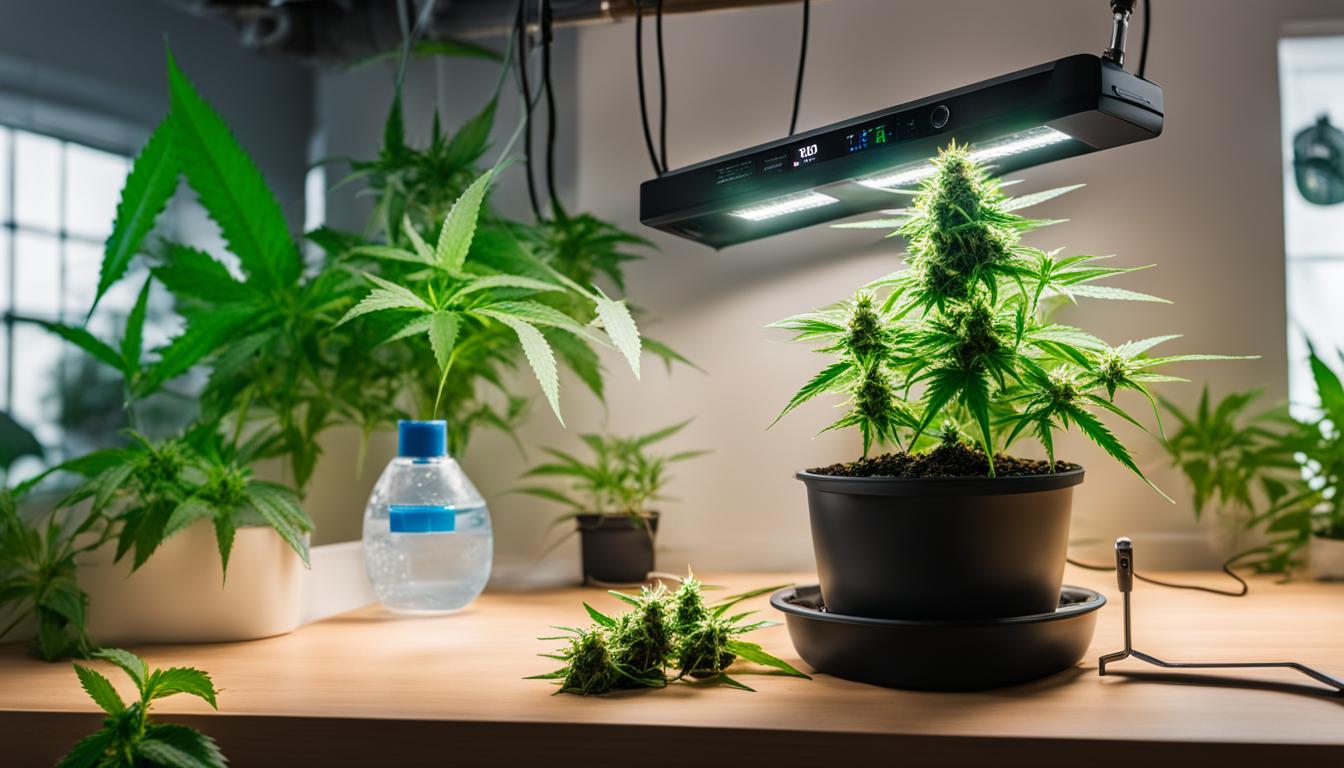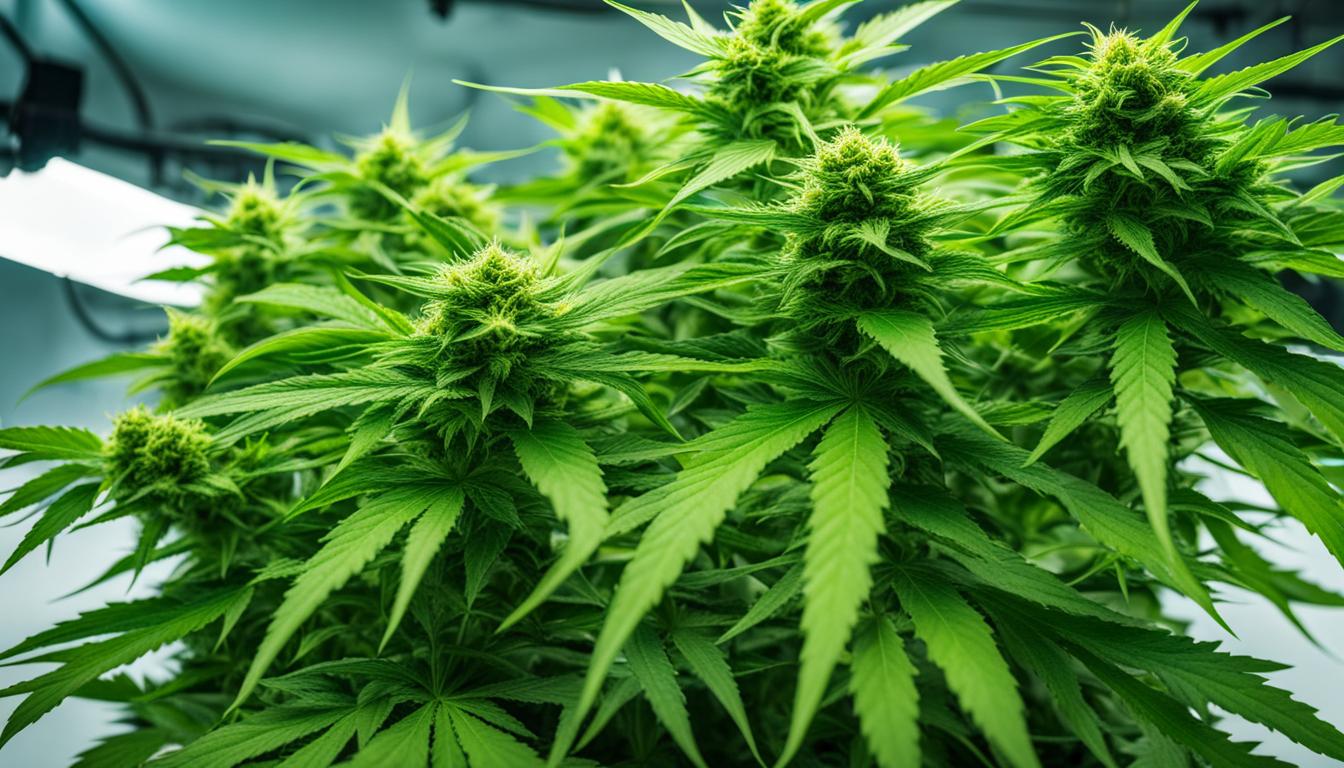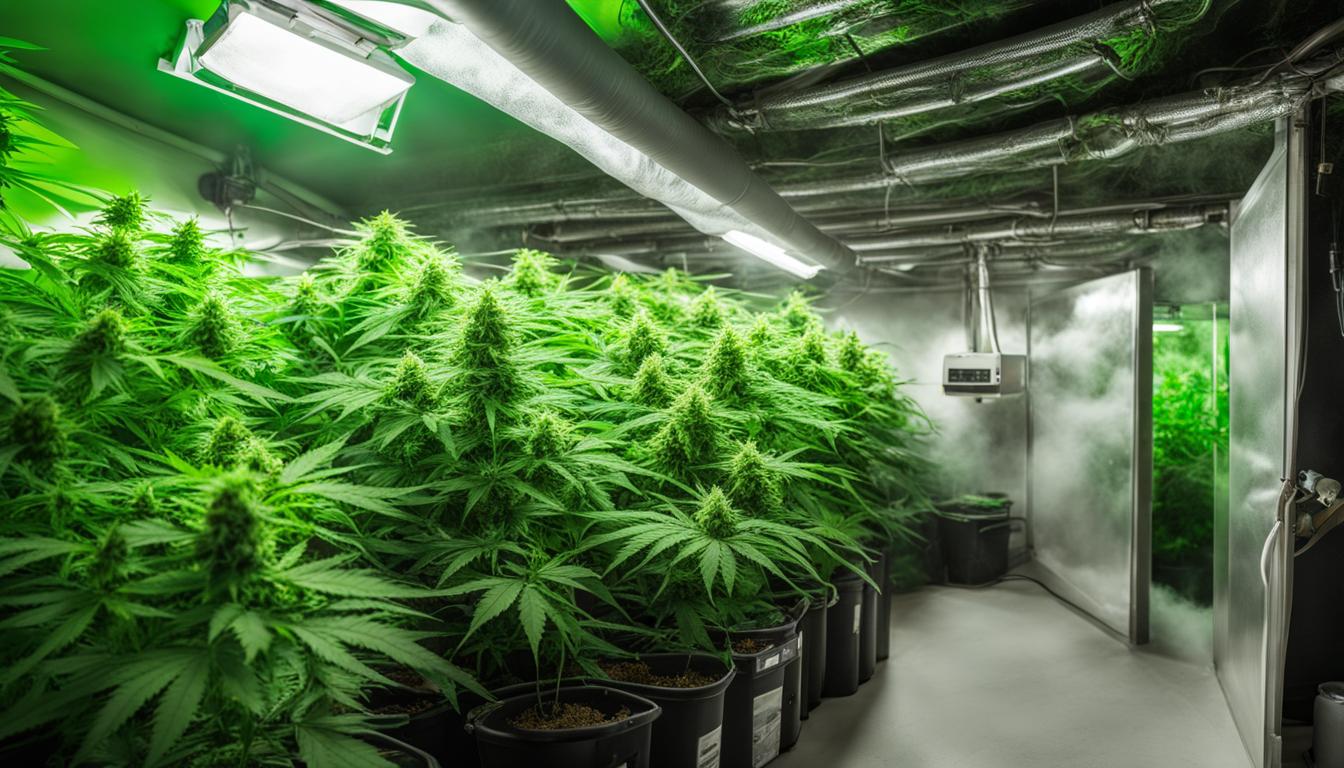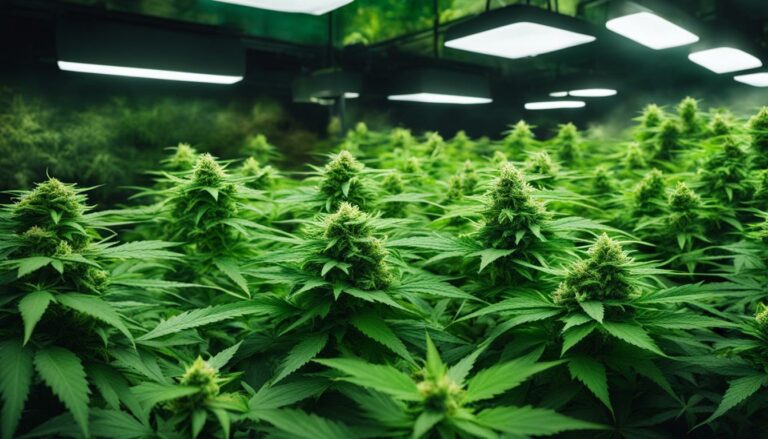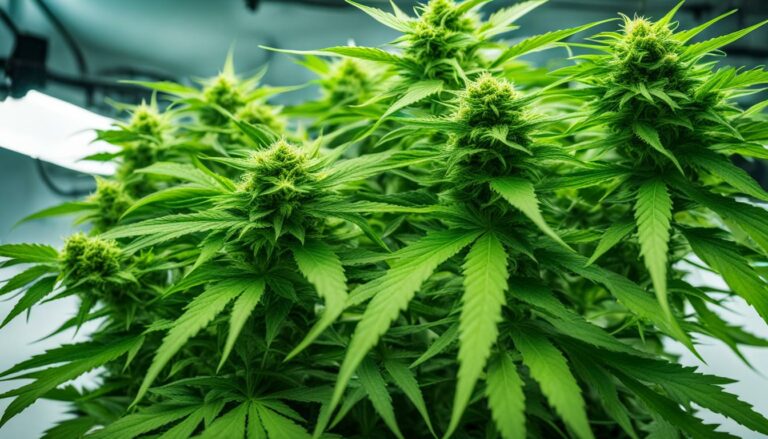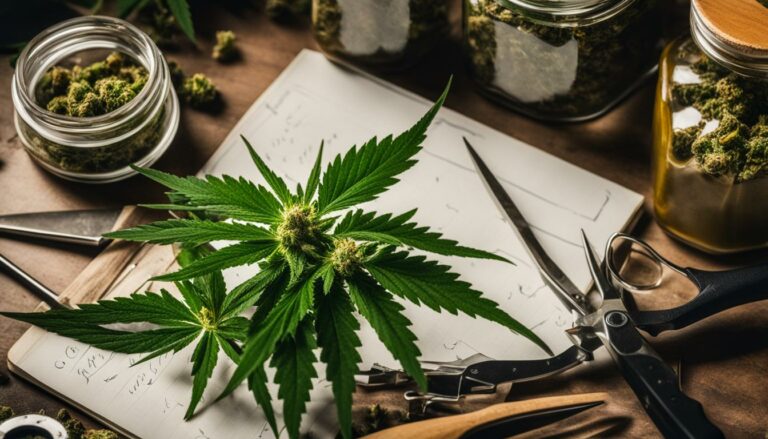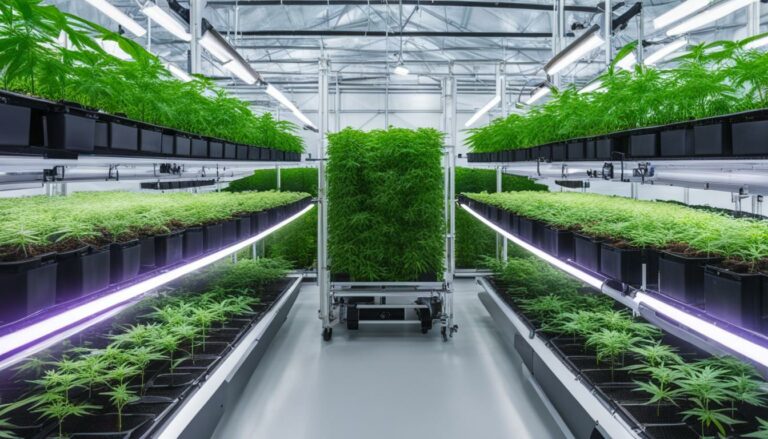DIY Cannabis Grow Rooms: Setup and Design
Are you ready to embark on a journey of cultivating your own cannabis? With a DIY cannabis grow room, you can turn your dream into a reality. Building your own grow room not only gives you control over the entire cultivation process but also ensures optimal conditions for successful plant growth. In this guide, we will provide you with valuable tips and tricks for setting up and designing your very own DIY cannabis grow room.
Whether you’re a novice or experienced grower, these cannabis growing tips will help you create the perfect environment for your plants. From choosing the right grow room equipment to implementing efficient cultivation techniques, we’ve got you covered. Say goodbye to relying on commercial grow rooms and hello to the satisfaction of growing your own cannabis at home.
Main Requirements for a DIY Cannabis Grow Room
When it comes to indoor cannabis cultivation, setting up a DIY grow room requires careful consideration of the main requirements. These requirements are essential for creating an environment that promotes healthy plant growth and maximizes your harvest. By meeting these requirements, you can ensure that your DIY cannabis grow room provides optimal conditions for successful cultivation.
Light-Proof
One of the primary requirements for a DIY cannabis grow room is to make it light-proof. Light leaks can disrupt the plant’s growth cycle and cause stress, leading to lower yields and compromised quality. Ensure that your grow room is properly sealed to prevent any light from entering or escaping. Consider using reflective materials such as mylar or white plastic to maximize light distribution within the grow space.
Waterproof
Another vital requirement is to make your DIY grow room waterproof. Water damage can lead to structural issues, mold, and rot, which can be detrimental to your plants. Choose materials that are water-resistant and easy to clean, such as plastic or tile. Proper drainage and waterproofing techniques should be implemented to ensure that excess water does not accumulate in the grow room.
Airtight
Airtightness is crucial for controlling temperature, humidity, and airflow in your DIY cannabis grow room. By maintaining a consistent and controlled environment, you can optimize plant growth and minimize the risk of pests and diseases. Seal all gaps and cracks to prevent air leakage, and consider using ventilation systems with carbon filters to manage airflow and odors effectively.
Different Types of Builds for DIY Cannabis Grow Rooms
When it comes to building your own DIY cannabis grow room, you have a range of options to choose from. Whether you want to repurpose existing spaces or build a custom structure, the choice is yours. Let’s explore the different types of builds and setups you can consider for your cannabis cultivation.
Repurposing Household Spaces
If you’re working with limited space or a tight budget, repurposing common household spaces can be a practical solution. Basements, cupboards, and closets can all be transformed into functional grow rooms. By utilizing these existing spaces, you can save both time and money on construction.
Custom Structures
If you have the resources and want to create a dedicated grow room, building a custom structure is an excellent option. You can choose from materials such as wood, metal, or plastic to construct a structure tailored to your specific needs. Custom structures provide the flexibility to optimize the layout and design according to your preferences.
Hydroponic Systems
When setting up your DIY cannabis grow room, you might also consider incorporating hydroponic systems . Hydroponics is a soilless cultivation method that uses water and nutrient solutions to feed the plants directly. This system provides precise control over nutrient delivery, resulting in faster growth and potentially higher yields compared to traditional soil-based cultivation.
Table: Pros and Cons of Different Build Types
| Build Type | Pros | Cons |
|---|---|---|
| Repurposing Household Spaces | – Cost-effective – Utilizes existing space – Easy to set up |
– Limited space – May require modifications – Potential for odor leakage |
| Custom Structures | – Tailored to your needs – Optimal layout design – Provides ample space |
– Higher cost – Requires construction skills – Longer setup time |
| Hydroponic Systems | – Precise nutrient control – Faster growth and potential higher yields – Water-efficient |
– Initial setup costs – Requires additional equipment – Steeper learning curve |
Remember, the type of build you choose will depend on factors such as available space, budget, and personal preferences. Consider your specific needs and goals when deciding on the right build type for your DIY cannabis grow room.
Building your Own DIY Cannabis Grow Room Step-by-step
Now that you have considered the main requirements and types of builds for your DIY cannabis grow room, it’s time to dive into the step-by-step process of building your own space. Follow these guidelines to create an optimal environment for your cannabis plants to thrive.
Growing Structure: Grow Tent or Grow Box
The first decision you need to make is whether to use a grow tent or a grow box as the structure for your grow room. A grow tent is a portable option that offers easy setup and flexibility, allowing you to adjust the size and configuration as needed. On the other hand, a grow box provides a more compact and discreet solution, making it ideal for smaller spaces or for growers who require more control over light leaks.
Whichever option you choose, make sure to select a size that accommodates your desired number of plants and provides enough space for proper ventilation and access for maintenance. Additionally, consider the material and quality of the structure to ensure durability and light-proofing.
Ventilation System: Ensuring Proper Airflow
Adequate ventilation is crucial for maintaining optimal conditions in your grow room. Proper airflow helps control temperature, humidity, and the exchange of carbon dioxide and oxygen, which are essential for plant growth. To achieve this, you’ll need to install an effective ventilation system.
Start by placing oscillating fans inside the grow room to promote air circulation and prevent stagnant air pockets. These fans also help strengthen the plant stems, preventing them from becoming weak and prone to breakage. Additionally, install exhaust fans to remove stale air and control temperature and humidity levels. Consider using carbon filters to eliminate odors and prevent the release of unwanted smells.
Lighting Fixtures: Providing the Right Spectrum
Proper lighting is vital for the growth and development of your cannabis plants. LED grow lights are a popular choice due to their energy efficiency and the ability to customize the light spectrum to meet the specific needs of each growth stage.
Calculate the appropriate wattage based on the square footage of your grow room to ensure sufficient light coverage. Hang the lights at the appropriate height to prevent heat damage to the plants and adjust the distance as the plants grow. Remember to follow the recommended light schedule for each growth stage, including the duration of light and dark periods.
Safety Precautions: Fire Prevention and Electrical Considerations
When building your DIY cannabis grow room, it’s important to prioritize safety to prevent any accidents and ensure the well-being of your plants. Take the necessary fire prevention measures, such as using fire-resistant materials and regularly inspecting electrical connections for any signs of wear or damage.
Proper electrical wiring is crucial to prevent electrical hazards. Make sure to use appropriate wiring, outlets, and extension cords that can handle the electrical load required by your lighting fixtures and other equipment. It’s also a good idea to use surge protectors or power strips with built-in surge protection to safeguard your equipment from power surges.
Summary
Building your own DIY cannabis grow room involves careful planning and attention to detail. Start by selecting the right structure, whether it’s a grow tent or a grow box, and ensuring proper ventilation to maintain optimal airflow. Choose the appropriate lighting fixtures for your plants’ needs and implement safety precautions, such as fire prevention measures and proper electrical wiring. By following these steps, you’ll be well on your way to creating a successful and efficient grow room for your cannabis cultivation.

Design Ideas for DIY Cannabis Grow Rooms
Your DIY cannabis grow room doesn’t have to be a plain and boring space. With a little creativity and inspiration, you can design a grow room that not only provides the optimal conditions for plant growth but also reflects your personal style. Here are some design ideas to help you create an inspirational and visually appealing grow room.
Ambient Lighting and Colors
Consider the use of ambient lighting in your grow room to create a soothing and inviting atmosphere. Soft, warm lights can enhance the overall aesthetics of the space and contribute to a relaxing environment. You can also experiment with different colors to create a visually stimulating and impactful ambiance. Incorporate LED strip lights or multi-colored bulbs for a vibrant and unique lighting effect.
Vertical Gardens and Living Walls
Add a touch of nature to your grow room by incorporating vertical gardens or living walls. These unique design elements not only beautify the space but also promote air purification and create a natural and refreshing environment for your plants. Install wall-mounted planters or create a trellis system for climbing plants to maximize vertical space and create a stunning focal point.
Artwork and Décor
Add a personal touch to your grow room by displaying artwork or decorative pieces that inspire you. Hang botanical prints, nature-themed paintings, or motivational quotes on the walls to create a visually stimulating and inspiring environment. Don’t forget to select artwork that complements the overall design and color scheme of your grow room.
Maximize Space with Shelving and Organization Systems
Efficient use of space is essential in a DIY cannabis grow room. Install shelving units, racks, or hanging baskets to maximize vertical and horizontal space, keeping your plants organized and easily accessible. Use decorative storage containers or labeled jars to store gardening tools, nutrients, and other supplies neatly. An organized and clutter-free space will not only enhance the visual appeal but also contribute to a more productive and enjoyable growing experience.
Tips for Pest Management in DIY Cannabis Grow Rooms
Pest management is an essential aspect of maintaining a healthy cannabis grow room. Dealing with pests can be challenging, but with proper preventive measures and swift action, you can ensure the well-being of your plants. Here are some helpful tips for effective pest management in your DIY cannabis grow room:
1. Regular Cleaning and Sanitation
Keeping your grow room clean and free from debris is the first line of defense against pests. Regularly remove any dead plant matter, fallen leaves, or other organic material that may attract pests. Sanitize your equipment, containers, and tools to minimize the risk of infestation. A clean environment is crucial for preventing pests from taking hold.
2. Organic Pest Control Methods
Opt for organic pest control methods to minimize the use of harmful chemicals in your grow room. Natural predators like ladybugs, predatory mites, and beneficial nematodes can help keep pest populations in check. Additionally, using organic insecticidal soaps and neem oil sprays can help control common pests like spider mites and aphids. Research and identify the best organic pest control solutions for your specific needs.
3. Regular Plant Inspection
Regularly inspect your plants for any signs of pest infestation. Look for yellowing or discolored leaves, webbing, holes in the foliage, or small insects crawling on the plants. Identifying pests early on allows you to take immediate action before the infestation spreads. If you spot any pests, quarantine affected plants and treat them promptly to prevent further damage.
4. Integrated Pest Management
Implement an integrated pest management (IPM) strategy to combat pests effectively. IPM involves a combination of cultural, biological, and chemical control methods to minimize the use of pesticides. By employing multiple approaches, you can disrupt pest lifecycles and reduce the risk of resistance. Regularly monitor your grow room conditions and adjust your pest management techniques accordingly.
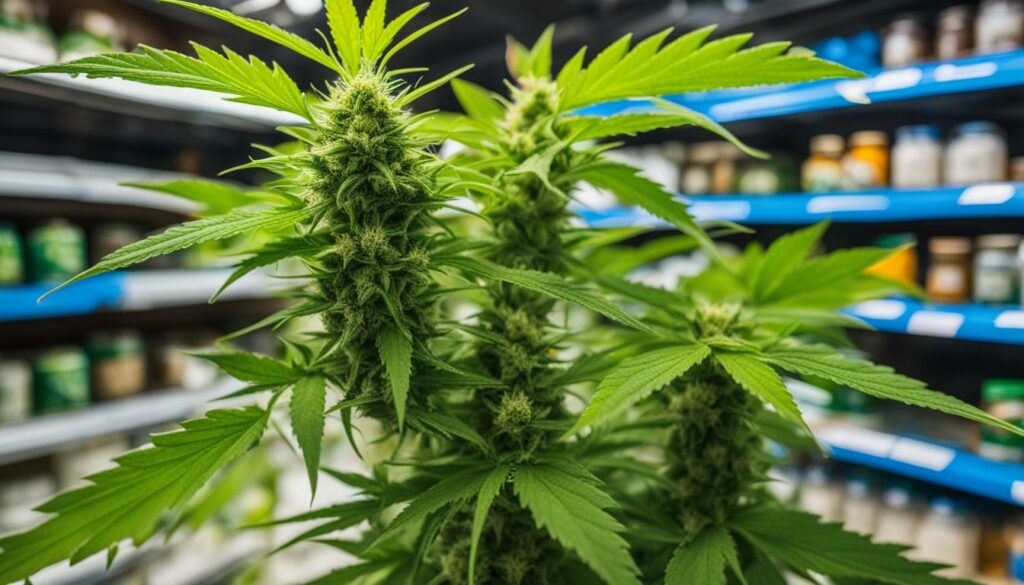
| Pest | Signs of Infestation | Control Methods |
|---|---|---|
| Aphids | Clustered insects on new growth, sticky residue (honeydew) on leaves | Organic insecticidal soaps, neem oil sprays, ladybugs |
| Spider Mites | Webbing, yellowing leaves, stippling damage | Neem oil sprays, predatory mites, increased humidity |
| Whiteflies | Small, white insects flying around plants, sticky residue on leaves | Yellow sticky traps, beneficial insects like parasitic wasps |
| Fungus Gnats | Small black flies, larvae in the soil, wilting plants | Sticky traps, beneficial nematodes, diatomaceous earth |
“Effective pest management is crucial for maintaining the health and productivity of your cannabis plants. By following these tips and staying vigilant, you can minimize the risk of pest infestations and ensure optimal growing conditions for your DIY cannabis grow room.” – Expert Grower
Choosing the Right Grow Medium for DIY Cannabis Grow Rooms
Growing cannabis in your DIY grow room requires careful consideration of the grow medium. The choice between soil and hydroponics can have a significant impact on the growth and overall success of your plants. Let’s explore the characteristics of each option to help you make an informed decision.
Soil-based Cultivation
Traditional soil-based cultivation is a popular choice for many cannabis growers. Soil provides a natural and forgiving growing environment that is rich in nutrients. It offers stability and can act as a buffer, helping to maintain optimal moisture levels for the roots. Additionally, soil contains beneficial microorganisms that contribute to the overall health of the plants.
When using soil, it’s important to choose a high-quality organic mix that is specifically formulated for cannabis cultivation. This will ensure that your plants receive the necessary nutrients for healthy growth. Regular watering and proper drainage are also essential to prevent overwatering or waterlogged soil conditions.
Hydroponic Systems
Hydroponics is a soilless growing method that allows for precise control over nutrient delivery and faster growth rates. Instead of soil, plants are grown in a nutrient-rich water solution that is continuously circulated. This method maximizes the availability of nutrients to the plants, leading to faster growth and potentially higher yields.
Hydroponic systems come in various forms, including deep water culture, nutrient film technique, and aeroponics. Each system has its own advantages and considerations, so it’s important to research and choose the one that best fits your needs and resources.
| Grow Medium | Pros | Cons |
|---|---|---|
| Soil | • Natural and forgiving • Contains beneficial microorganisms • Acts as a buffer for moisture |
• Requires proper drainage • Can be more challenging to maintain precise nutrient levels |
| Hydroponics | • Precise control over nutrient delivery • Faster growth rates • Potentially higher yields |
• Requires more setup and maintenance • Potential for system failures • Higher upfront costs |
Optimizing Light and Temperature in DIY Cannabis Grow Rooms
Proper lighting and temperature control are essential for the successful growth of cannabis plants in DIY grow rooms. By optimizing these factors, you can create an ideal environment that promotes healthy plant development and maximizes yields. Two key aspects to focus on are LED grow lights and temperature control.
LED Grow Lights
LED grow lights have revolutionized indoor cannabis cultivation due to their energy efficiency and customizable light spectrum. Unlike traditional lighting sources, such as HPS or fluorescent lights, LED grow lights consume less electricity and produce less heat, reducing the risk of overheating your plants. Furthermore, LED lights allow you to tailor the light spectrum to the specific needs of each growth stage, providing the ideal wavelengths for photosynthesis and optimal plant growth.
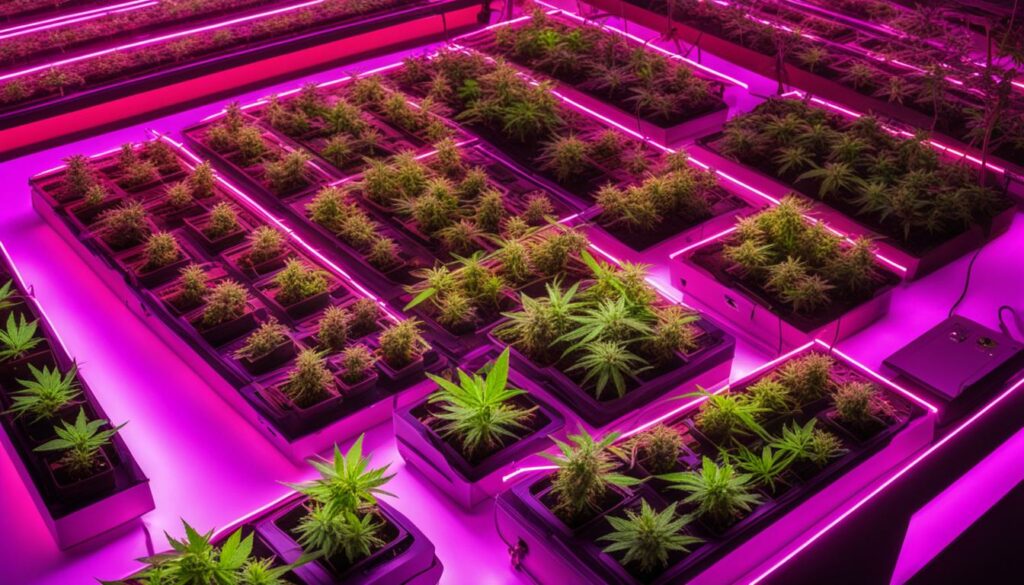
When choosing LED grow lights, consider the wattage and coverage area of the lights. Higher wattage lights are suitable for larger grow rooms, while lower wattage lights are ideal for smaller spaces or specific plant sections. Additionally, ensure that the lights have a full spectrum of colors, including blue for vegetative growth and red for flowering. Regularly monitor the distance between the lights and your plants to avoid light burn or insufficient light intensity.
Temperature Control
Maintaining the right temperature range is crucial for the health and productivity of your cannabis plants. During the vegetative stage, aim for a temperature range of 70-85°F (21-29°C) to promote vigorous growth and root development. As the plants transition into the flowering stage, slightly lower temperatures to around 65-80°F (18-27°C) can help enhance resin production and bud development.
To achieve optimal temperature control, utilize a combination of devices such as fans, heaters, and air conditioners. Oscillating fans can help circulate the air, prevent hot spots, and strengthen plant stems. Heaters can be used to increase the temperature in cooler climates, while air conditioners or fans with temperature controls can be used to cool the grow room in warmer environments.
Monitor the temperature regularly using a thermometer or digital controller and make adjustments as needed to maintain the desired range. Remember that temperature fluctuations, especially drastic ones, can stress your plants and negatively impact growth. Aim for a stable and consistent temperature throughout the day and night.
| Optimizing Light and Temperature Tips for DIY Cannabis Grow Rooms |
|---|
| Choose LED grow lights with the appropriate wattage and full spectrum of colors for each growth stage |
| Regularly monitor the distance between the lights and your plants to avoid light burn or insufficient light intensity |
| Maintain a temperature range of 70-85°F (21-29°C) during the vegetative stage and 65-80°F (18-27°C) during the flowering stage |
| Utilize oscillating fans, heaters, and air conditioners to maintain proper airflow and temperature control |
| Monitor the temperature regularly using a thermometer or digital controller |
By optimizing light and temperature in your DIY cannabis grow room, you can create the ideal conditions for your plants to thrive. LED grow lights provide energy-efficient and customizable lighting, while temperature control ensures that your plants are not subjected to unnecessary stress. Remember to regularly monitor and adjust these factors to maintain the best possible environment for your cannabis cultivation.
Nutrient Management in DIY Cannabis Grow Rooms
Proper nutrient management is crucial for ensuring healthy and thriving cannabis plants in your DIY grow room. Cannabis has specific nutrient requirements throughout its growth stages, and providing the right nutrients at the right time is essential for optimal plant health and maximum yields.
During the vegetative stage, cannabis plants require a higher concentration of nitrogen to support the development of lush foliage and strong stems. Nitrogen-rich fertilizers, such as those with a higher NPK ratio, should be used during this stage to promote vigorous growth.
As the plants transition into the flowering stage, their nutrient requirements change. Phosphorus and potassium become more important for bud development and overall plant health. It’s crucial to switch to a bloom-specific fertilizer with a higher PK ratio to provide the necessary nutrients for robust flower formation.
Nutrient Schedule for Cannabis:
| Growth Stage | Nutrient Requirements |
|---|---|
| Vegetative | Higher concentration of nitrogen for foliage development |
| Flowering | Increased phosphorus and potassium for bud development |
It’s important to follow a nutrient schedule tailored to the specific needs of cannabis plants. This schedule outlines the timing and dosage of fertilizers, ensuring that your plants receive the right nutrients at each stage of their growth. Regular monitoring of the plant’s nutrient levels using a TDS/EC meter can help you make any necessary adjustments to maintain optimal nutrient balance.
Remember that nutrient management goes hand in hand with proper watering practices. Overfeeding or underfeeding your plants can lead to nutrient deficiencies or toxicities. Always follow the manufacturer’s instructions for fertilizers and adjust accordingly based on your plants’ response and overall health.
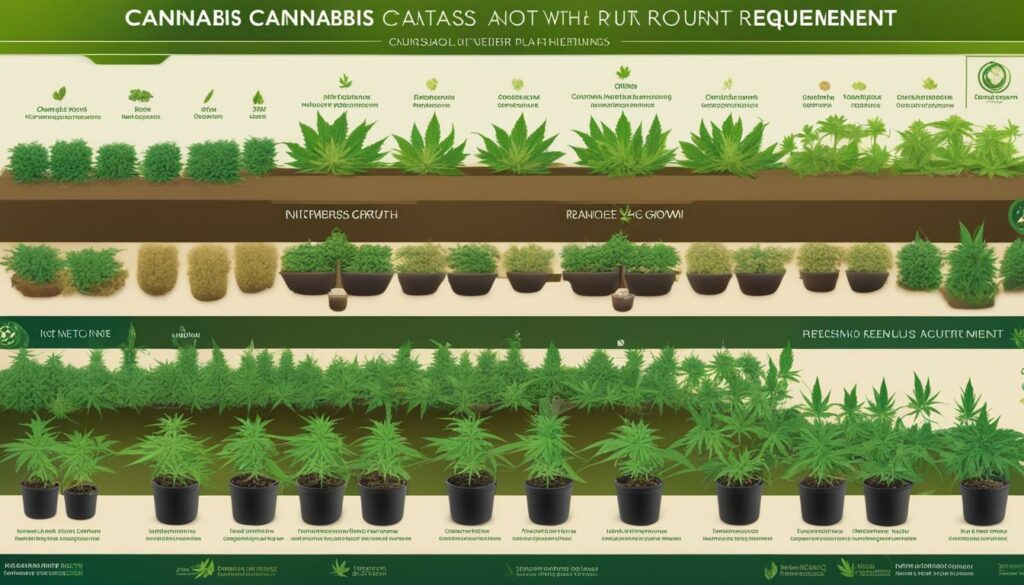
“Proper nutrient management is key to ensuring healthy and thriving cannabis plants in your DIY grow room.”
Harvesting and Drying in DIY Cannabis Grow Rooms
Once your cannabis plants have reached their peak maturity, it’s time to harvest and dry them to preserve their potency and flavor. Harvesting cannabis at the right time is crucial, as it ensures that the trichomes, which contain the valuable cannabinoids and terpenes, have fully developed. To determine the ideal time for harvest, closely monitor the trichomes using a magnifying glass or jeweler’s loupe. Harvest when the majority of trichomes appear milky white with a few amber ones, indicating peak potency.
When it comes to drying your harvested buds, it’s essential to create the optimal environment. Hang your cannabis plants upside down in a cool, dark, and well-ventilated space with a humidity level of around 50%. This allows for a slow and controlled drying process, which is crucial for preserving the potency, aroma, and overall quality of your buds. Avoid drying your cannabis too quickly, as this can result in harsh-tasting and less potent buds.
During the drying process, regularly check the moisture content of your buds by gently bending the stems. If they snap easily, it’s an indication that your cannabis is sufficiently dry. Once your buds are dry, it’s time for the curing process. Place the dried buds in airtight containers, such as glass jars, and store them in a cool and dark place. Open the containers once or twice a day to release excess moisture and allow for proper curing. Curing your cannabis for at least two weeks helps enhance the flavor, aroma, and smoothness of the final product.
Drying and Curing Tips:
- Avoid using high heat or direct airflow during the drying process, as they can degrade the potency and quality of your buds.
- Use humidity packs or Boveda packs in your storage containers to maintain the ideal humidity level of around 62% for optimal curing.
- Regularly inspect your drying and curing buds for any signs of mold or mildew, and remove any affected buds immediately to prevent further contamination.
By following proper harvesting, drying, and curing techniques, you can ensure that your DIY cannabis grow room produces high-quality, flavorful buds that deliver the desired effects.
| Harvesting Tips | Drying and Curing Tips |
|---|---|
| Monitor trichomes for maturity | Avoid high heat and direct airflow |
| Harvest when trichomes are mostly cloudy | Use humidity packs in storage containers |
| Hang plants upside down in a cool, dark space | Regularly inspect buds for mold or mildew |
| Slow and controlled drying process | Remove any affected buds immediately |
| Avoid drying too quickly |
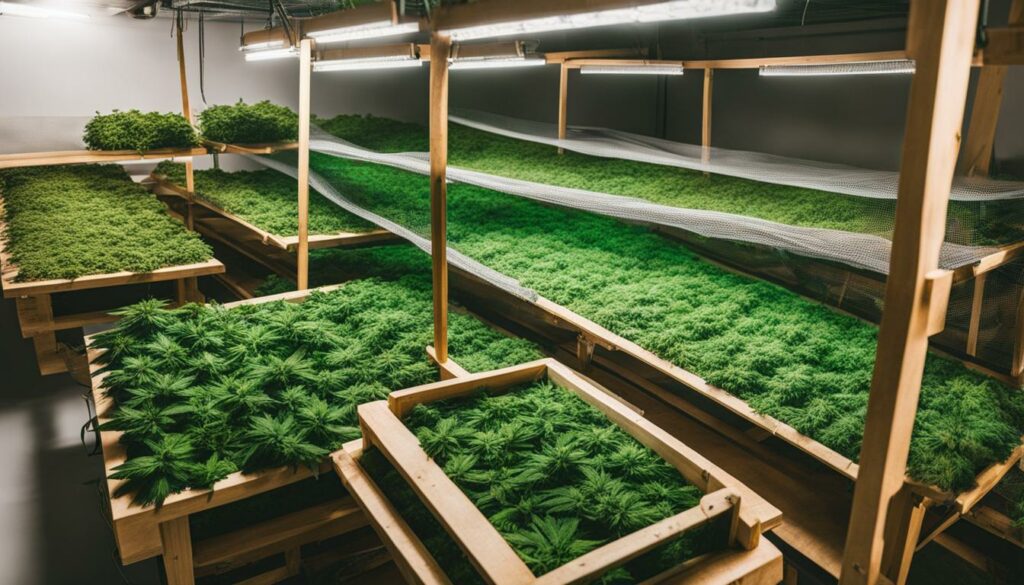
Troubleshooting Common Issues in DIY Cannabis Grow Rooms
Troubleshooting common issues in DIY cannabis grow rooms is an essential part of maintaining a successful cultivation space. As a grower, it is inevitable to encounter various problems that can impact the health and growth of your cannabis plants. By being proactive and addressing these issues promptly, you can ensure the best possible results from your DIY grow room. Let’s explore some common problems and their troubleshooting solutions:
Pest Infestations
Pests are a common nuisance in cannabis grow rooms and can wreak havoc on your plants if left untreated. Identifying and eliminating pests at an early stage is crucial. Look out for signs such as yellowing leaves, holes in the foliage, or webbing. Implement preventive measures such as regular cleaning, maintaining proper sanitation, and using organic pest control methods. If infestation occurs, consider using natural pest repellents or introducing beneficial insects to your grow room.
Nutrient Deficiencies
Cannabis plants require a balanced supply of nutrients to thrive. Nutrient deficiencies can manifest in various ways, such as discolored or spotted leaves, stunted growth, or nutrient burn. It is important to monitor your plants’ nutrient levels regularly and adjust the feeding schedule accordingly. Ensure that you are providing the correct amount and ratio of nutrients for each growth stage. Consider using organic fertilizers or supplements to address specific nutrient deficiencies.
Environmental Fluctuations
Fluctuations in temperature, humidity, and airflow can significantly impact the health and growth of your cannabis plants. Maintain a stable environment within the optimal range for each growth stage. Use temperature control devices such as fans, heaters, and air conditioners to regulate the temperature. Monitor humidity levels and use dehumidifiers or humidifiers as needed. Ensure proper air circulation and ventilation to prevent stagnant air and mold growth. Regularly check and adjust your grow room environment to maintain consistency.
| Problem | Solution |
|---|---|
| Pest Infestations | Identify pests early, use organic pest control methods, and consider introducing beneficial insects. |
| Nutrient Deficiencies | Monitor nutrient levels regularly, adjust feeding schedule, and consider using organic fertilizers or supplements. |
| Environmental Fluctuations | Maintain stable temperature, humidity, and airflow using appropriate devices and regular monitoring. |
These are just a few examples of common issues you may encounter in your DIY cannabis grow room. Remember to observe your plants closely, research potential problems, and take immediate action to resolve them. Each grow room is unique, and troubleshooting is an ongoing process that requires attentiveness and adaptability. By addressing issues promptly and providing the optimal growing conditions, you can ensure a successful and bountiful harvest from your DIY cannabis grow room.
Related Articles
- How to Design an Efficient Cannabis Grow Room at Home?
- What Are the Key Considerations for DIY Cannabis Grow Room Setup?
- How to Optimize Space in Your Home for Cannabis Cultivation?
- What Are the Budget-Friendly Ways to Set Up a Cannabis Grow Room?
- How to Ensure Safety and Security in Your DIY Cannabis Grow Room?
Conclusion
Congratulations on taking the first step towards building your own DIY cannabis grow room! With this guide, you now have the knowledge to create a space that meets all the requirements for successful cannabis cultivation. By implementing proper ventilation and lighting, managing pests and nutrients, and optimizing the environment, you can maximize your yields and produce high-quality cannabis.
Remember, your DIY cannabis grow room is not just a functional space but also an opportunity to create a visually appealing environment. Get creative with design elements that inspire you, such as reflective materials and decorative elements. Make your grow room a place that reflects your personal style and enhances your growing experience.
As you embark on this journey, always stay proactive in addressing any challenges that may arise. Regularly inspect your plants for signs of problems and take immediate action. Keep a journal to track your grow room conditions, and make adjustments as needed to ensure the health and vitality of your plants.
So, embrace the possibilities of DIY cannabis cultivation and enjoy the rewards of your efforts. Cultivate your own cannabis in your DIY grow room, using the techniques you have learned, and watch as your green thumb flourishes. Happy growing!
FAQ
What are the main requirements for a DIY cannabis grow room?
The main requirements for a DIY cannabis grow room are that it needs to be light-proof, waterproof, and airtight to ensure optimal conditions for successful cultivation.
What are the different types of builds for DIY cannabis grow rooms?
You have several options for the type of build for your DIY cannabis grow room. You can repurpose common household spaces like basements, cupboards, and closets, or you can build a custom structure using materials like wood, metal, or plastic.
How do I build my own DIY cannabis grow room?
To build your own DIY cannabis grow room, you need to choose between a grow tent or a grow box as the structure. You also need to ensure proper ventilation, install lighting fixtures, and consider safety precautions such as fire prevention measures and electrical wiring considerations.
How can I make my DIY cannabis grow room visually appealing?
You can incorporate design elements like reflective materials for maximizing light distribution, as well as adding decorative elements such as wall art or plants to create a calming and inviting atmosphere.
How can I manage pests in my DIY cannabis grow room?
It’s important to regularly clean your grow room, practice proper sanitation, and use organic pest control methods to prevent infestation. Regularly inspect your plants for signs of pests and take immediate action to eliminate them.
What is the best grow medium for DIY cannabis grow rooms?
You can choose between traditional soil-based cultivation or hydroponic systems. Soil offers natural nutrients and a forgiving growing environment, while hydroponics provide precise control over nutrient delivery and faster growth rates.
How can I optimize light and temperature in my DIY cannabis grow room?
LED grow lights are a popular choice for their energy efficiency and customizable light spectrum. It’s important to maintain the right temperature range and use temperature control devices like fans, heaters, and air conditioners.
What should I consider for nutrient management in my DIY cannabis grow room?
Start with high-quality nutrients designed for cannabis cultivation and follow the recommended nutrient schedule. Focus on nitrogen-rich nutrients during the vegetative stage and switch to phosphorus and potassium-rich nutrients during the flowering stage.
How do I harvest and dry cannabis in my DIY grow room?
Monitor the trichomes for maturity and harvest when they are mostly cloudy with some amber ones. After harvest, dry your buds slowly in a controlled environment with proper airflow and humidity. Store them in airtight containers for curing.
What are some common issues in DIY cannabis grow rooms and how can I troubleshoot them?
Common issues include nutrient deficiencies, pests, diseases, and environmental fluctuations. Regularly inspect your plants, research common issues, and take immediate action to address any concerns.

